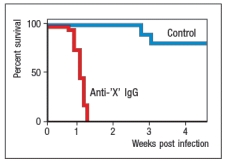Multiple Choice
Toxoplasma gondii is a single-celled parasitic protozoan that infects and replicates in macrophages. It is common in the environment, and is transmitted to humans by the ingestion of undercooked meat or by accidental ingestion of the parasite's oocytes from contaminated water or cat litter. Infected individuals with healthy immune systems are generally asymptomatic, and rapidly clear the infection. However, in AIDS patients, infections of Toxoplasma gondii can lead to severe disease and even death. To investigate the immune mechanisms important in controlling Toxoplasma gondii, a mouse model of the infection was developed. Mice were infected with the protozoa at a dose where the majority of the mice survive the infection, and at the same time, were injected with a neutralizing antibody to a cytokine made by T cells (anti-'X' IgG) . A second group of mice received the protozoa plus a control IgG antibody, as shown in Figure Q10) .  Figure Q10) The most likely candidate for cytokine 'X' is:
Figure Q10) The most likely candidate for cytokine 'X' is:
A) IFN-
B) IL-2
C) IL-4
D) IL-17
E) GM-CSF
Correct Answer:

Verified
Correct Answer:
Verified
Q18: It is well documented that antibody affinities
Q19: In response to an intracellular bacterial
Q20: Vaccinia virus, used to immunize individuals against
Q21: Studies in mice have shown that
Q22: Allergic airway inflammation can be induced in
Q23: Following an acute virus infection in which
Q24: The immune response to helminthic worm infections
Q25: Initially after an infection, the majority of
Q26: Salmonella typhimurium is a Gram-negative bacterial
Q27: A set of mice are each immunized